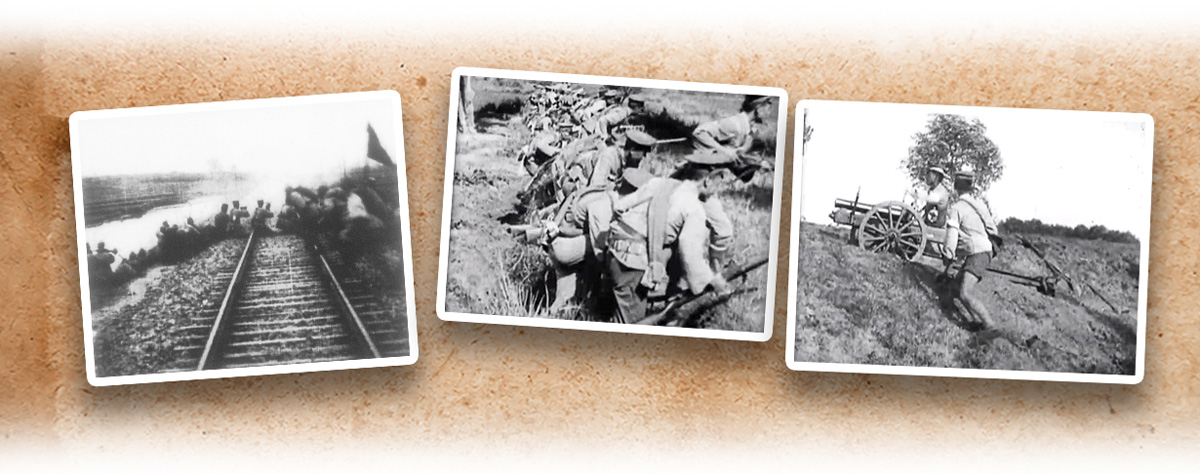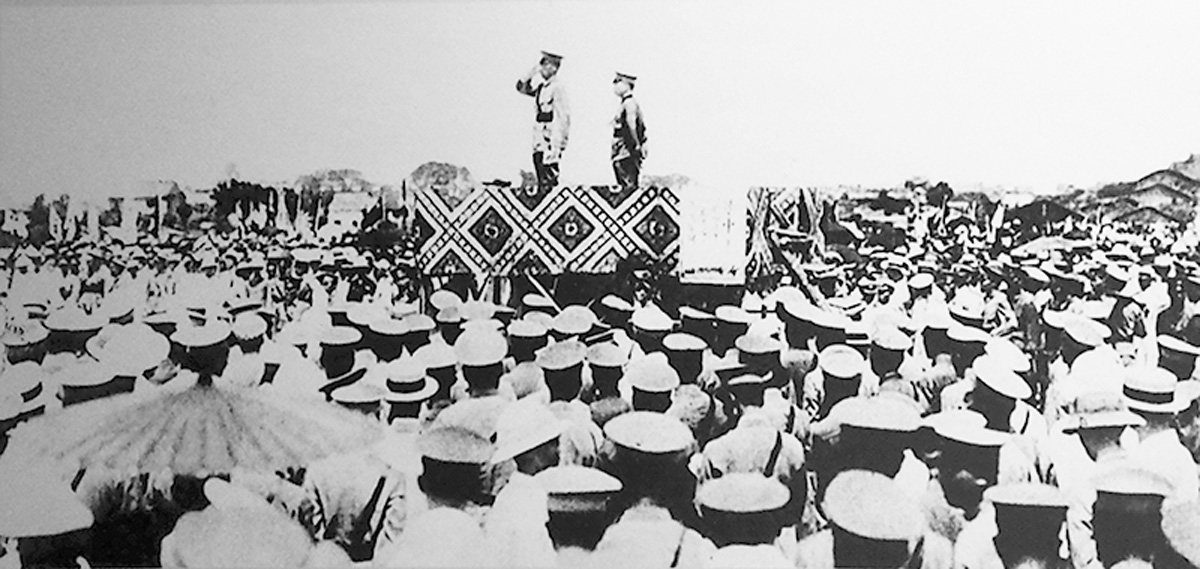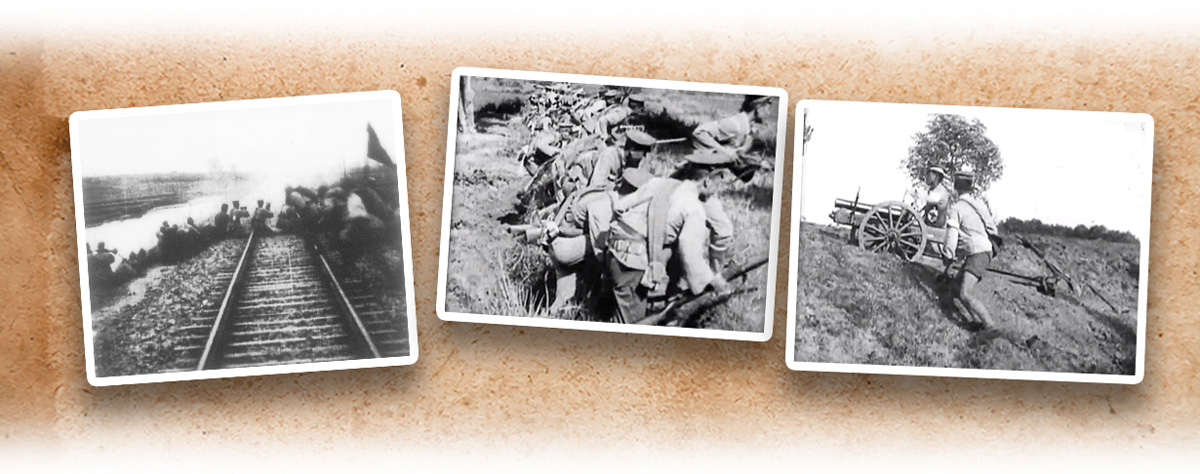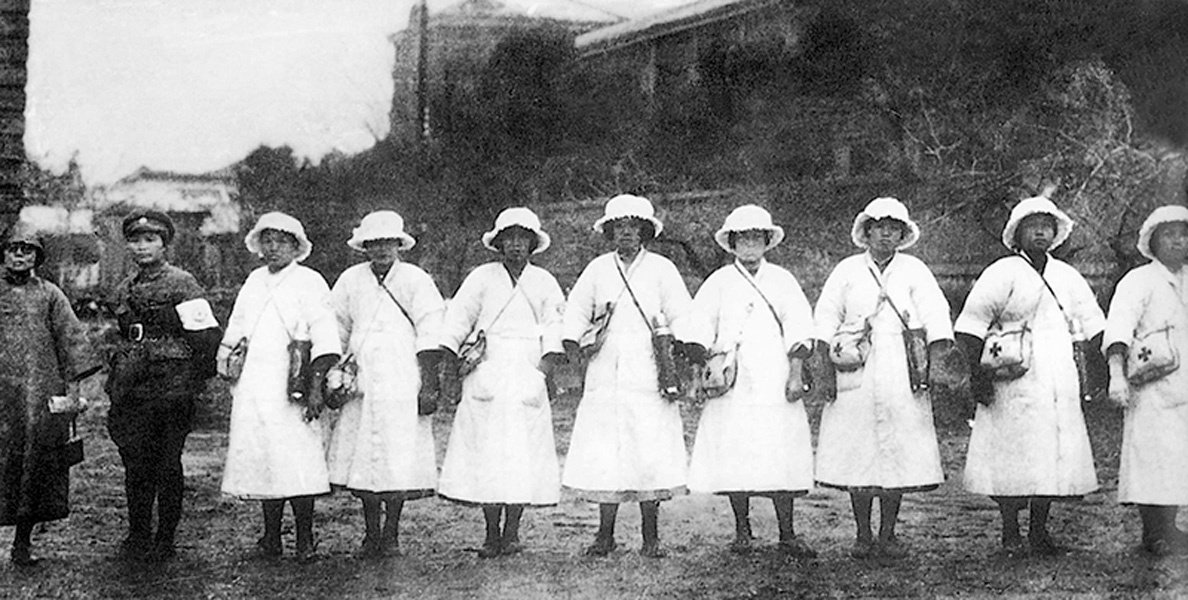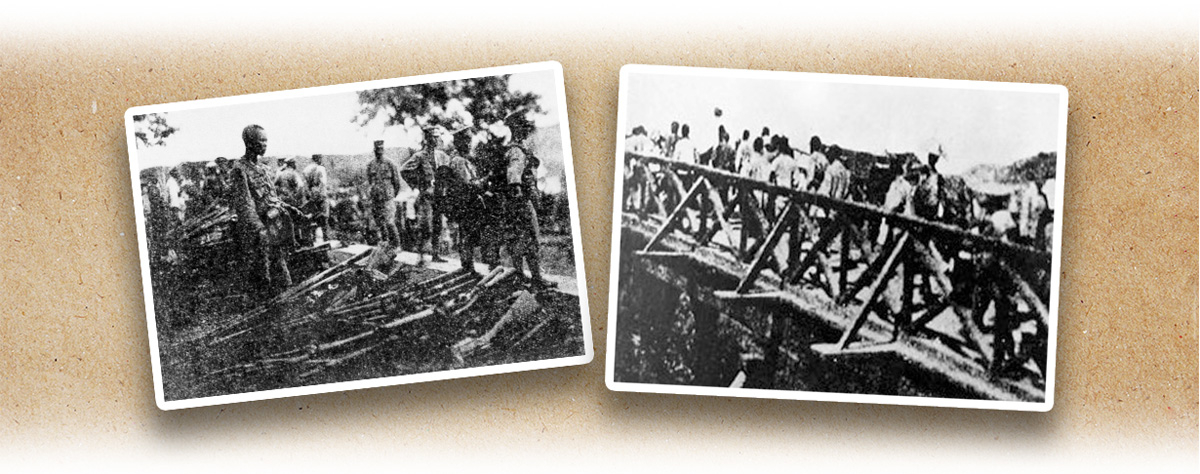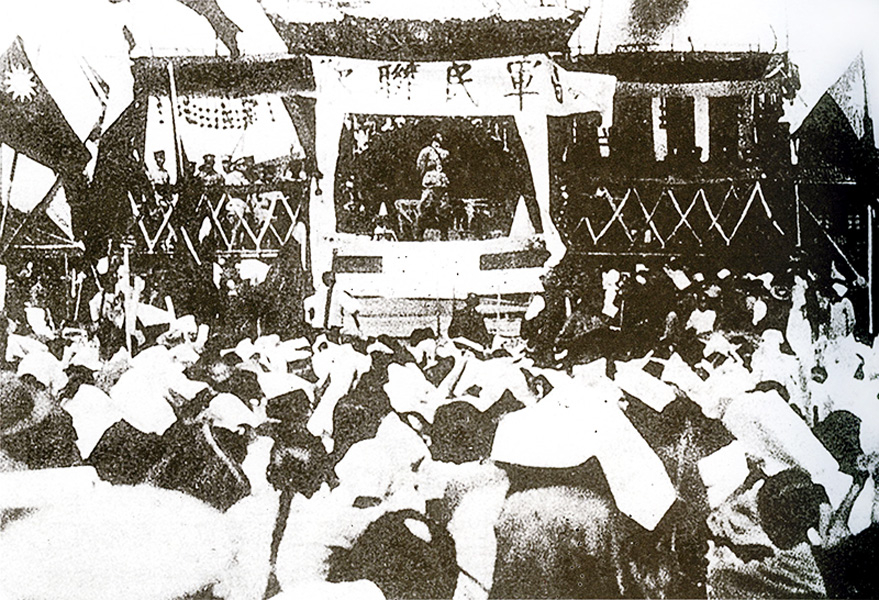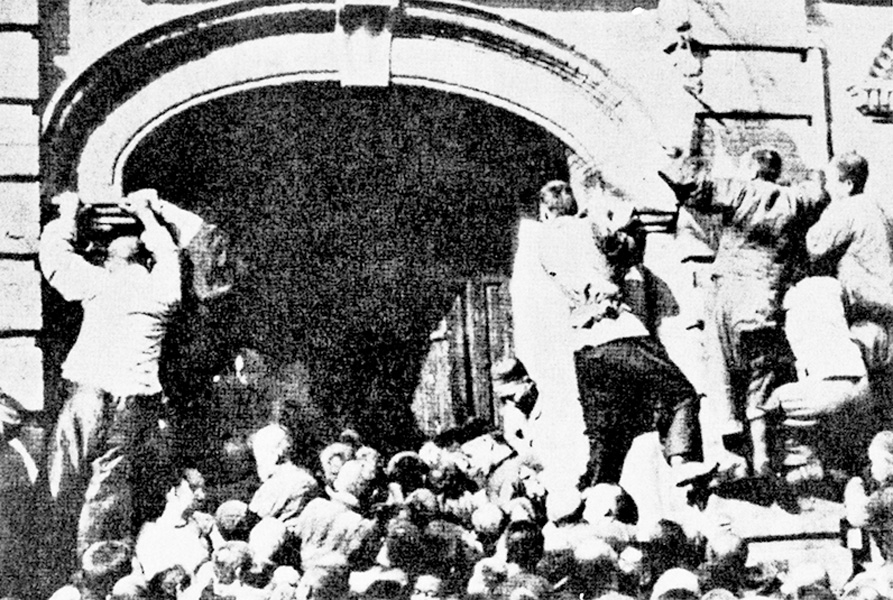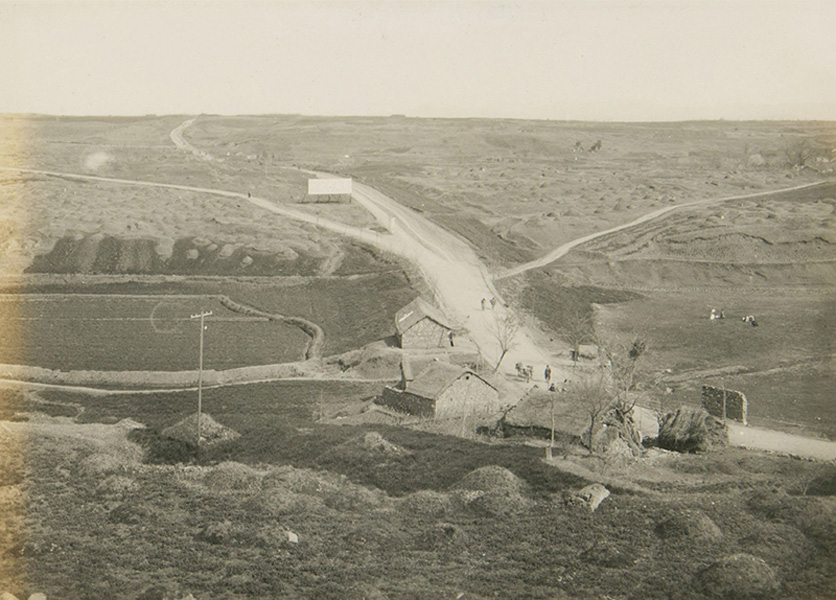Sun Yat-sen’s (孫中山) last wish of reunifying China by the Northern Expedition was unfulfilled. At that time, the Fengtian clique (奉系) warlord Zhang Zuolin (張作霖) who dominated Northeast China and parts of north China, and the Zhili clique (直系) warlords Wu Peifu (吳佩孚) and Sun Chuanfang (孫傳芳) occupied central and southeast China respectively. The three major warlords controlled about 800,000 forces.
On 1 July 1925, the Generalissimo Sun Yat-sen’s Mansion was reorganised into the Nationalist Government in Guangzhou (廣州), with Wang Jingwei (汪精衛) as chairman. In August of the same year, the Nationalist Government named the troops under its jurisdiction the National Revolutionary Army (NRA). On 9 July 1926, the NRA took the oath of the Northern Expedition in Guangzhou, with Chiang Kai-shek (蔣介石) as commander-in-chief.
The NRA was an irresistible force even with only 100,000 soldiers when the Northern Expedition was first launched. While heavily hitting the main force of Wu Peifu in the provinces of Hunan (湖南) and Hubei (湖北) and successfully capturing Changsha (長沙) and Wuhan (武漢), the NRA also defeated Sun Chuanfang’s force in the provinces of Jiangxi (江西) and Fujian (福建). The NRA then marched from Zhejiang Province (浙江) to Nanjing (南京) and Shanghai (上海). By the end of 1926, the Northern Expedition had already won a significant victory.
In January 1927, the Nationalist Government moved from Guangzhou to Wuhan, and took over the British concession in Hankou (漢口). On 23 March 1927, the NRA captured Nanjing, marking the elimination of Wu Peifu’s and Sun Chuanfang’s forces.
|
|
Was there any evidence to prove that the Northern Expedition was jointly initiated by the Kuomintang of China (KMT, 中國國民黨) and the Chinese Communist Party (CCP, 中國共產黨) during the Republican period? What were the famous battles won by the NRA? |
|
|
See answer below. |
On 1 July 1925, the Nationalist Government reorganised from the Generalissimo Sun Yat-sen’s Mansion was established in Guangzhou, with Wang Jingwei as chairman. The New Guangxi clique (新桂系) led by Li Zongren (李宗仁), Bai Chongxi (白崇禧), Huang Shaohong (黃紹竑), and Huang Xuchu (黃旭初) also supported the Nationalist Government in Guangzhou. Before the Northern Expedition, the Nationalist Government in Guangzhou had already controlled Guangdong (廣東) and Guangxi (廣西), which laid a solid foundation for this military campaign.
On 9 July 1926, the NRA took the oath of the Northern Expedition in Guangzhou.
Left: On 9 July 1926, Chiang Kai-shek reviewed the troops as commander-in-chief of the NRA at the oath-taking ceremony for the Northern Expedition. Right: A photo of Chiang during the Northern Expedition.
Although far fewer in number than the warlords’ armies, the well-trained NRA’s revolutionary ideals and high morale overwhelmed the enemy. Left: The NRA marching along the railway. Middle: The infantry of the NRA jumping out from the trenches to attack. Right: The artillery of the NRA in battle.
The Women’s First-Aid Team of the NRA responsible for rescuing wounded soldiers.
The NRA first attacked Wu Peifu’s troops in the middle reaches of the Yangtze River (長江). In July 1926, the NRA captured Changsha, the capital of Hunan. In August, it attacked Hubei and defeated Wu in two key battles in the Tingsi Bridge and the Hesheng Bridge respectively. Left: Firearms seized by the NRA in the Tingsi Bridge Battle. Right: Prisoners of war captured by the NRA in the Hesheng Bridge Battle.
After the Tingsi Bridge Battle and the Hesheng Bridge Battle, the NRA set its sight on the “Three Towns of Wuhan”, namely Wuchang (武昌), Hankou, and Hanyang (漢陽). It captured Hanyang and Hankou on 6 and 7 September 1926 respectively. Left: The NRA entering Hanyang. Right: The NRA ready to attack Wuchang.
On 10 October 1926, the 15th anniversary of the Wuchang Uprising of the 1911 Revolution, the NRA captured Wuchang. The picture shows the army-civilian get-together held after the NRA conquered Wuchang. Unlike many warlords’ armies, the NRA was disciplined and never infringed on the people’s interests. Therefore, it won the support of the people. After the NRA acquiring the “Three towns of Wuhan”, Wu Peifu’s forces were basically eliminated. The Nationalist Government moved from Guangzhou to Wuhan in January 1927.
The Nationalist Government in Wuhan took over the British concession in Hankou. On 19 February 1927, the Nationalist Government and Britain signed an agreement, which marked the successful recovery of the British concession in Hankou and greatly enhanced the prestige of the Nationalist Government.
Outside Nanjing, Jiangsu Province (江蘇), photographed sometime between 1926 and 1927. After defeating Wu Peifu, the NRA concentrated forces against Sun Chuanfang who controlled south-east China. The NRA captured Nanjing on 23 March 1927, marking the elimination of Sun Chuanfang’s forces. The Northern Expedition fought with incredible force, igniting the hope that the decade-long chaos since the founding of the Republic of China would end.
|
|
Was there any evidence to prove that the Northern Expedition was jointly initiated by the KMT and the CCP? What were the famous battles won by the NRA? |
|
|
The KMT and the CCP began to cooperate at the First National Congress of the Kuomintang of China held in January 1924, during which the Northern Expedition was planned. Chiang Kai-shek took office as commander-in-chief of the NRA. In the army, Li Jishen (李濟深) served as Chief of Staff, Deng Yanda (鄧演達) and Zhou Enlai (周恩來) as Director and Deputy Director of the Department of Politics respectively. Many CCP members served as party representatives of various armies. For example, Zhou (Deputy Party Representative at the First Army), Li Fuchun (李富春, Deputy Party Representative at the Second Army), Xiao Jinguang (蕭勁光, Party Representative at the Sixth Division of the Second Army), Zhu Kejing (朱克靖, Party Representative at the Third Army), Luo Han (羅漢, Party Representative at the Fourth Army), and Lin Boqu (林伯渠, Deputy Party Representative at the Sixth Army). In commanding operations, the “Iron Army” led by the CCP member Ye Ting (葉挺) was in high repute. Ye originally led the armoured fleet of the former Generalissimo’s Mansion (the fleet consisted of students from the Whampoa Military Academy and the mainstay of workers and peasants movement selected by Zhou), which was later reorganised to be under the 34th Regiment, the 12th Division, the 4th Army of the NRA led by Li Jishen (and soon renamed the Independent Regiment). During the Northern Expedition, Ye’s Independent Regiment, as the advance force, participated in the battles of Lutian (淥田), Longjiawan (龍家灣), Liling (醴陵), Pingjiang (平江), the Tingsi Bridge, the Hesheng Bridge, and Wuchang, marching to Hunan and Hubei all the way from Guangdong. With outstanding military successes, the 4th Army earned the reputation “Iron Army”. In addition, Wang Tianpei (王天培), the former commander-in-chief of the Third Route Army in the Northern Expedition, led the Tenth Army and others to advance northward from Zhenjiang (鎮江), Changshu (常熟), and Wuhu (蕪湖). The troops immediately won a great victory at Xuzhou (徐州) and crushed the enemy. However, Wang was later killed because he refused to follow the “Party Purge” order. |
Sources of most photos used in this feature piece: Visual China Group (pictures 2, 3, and 8), Fotoe (pictures 4, 5, 6, 7, 9, and 10), and misc. photo sources.




